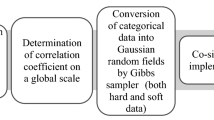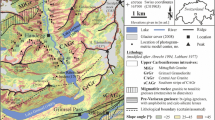Abstract
Vein-hosted gold deposits are characterized by mineralization, which is spatially restricted to narrow vein structures. Drillholes intersecting a mineralized vein can lead to unreliable and biased assay values compared to selective mining unit scale block grades. In this work, a discrete fracture network is simulated and adapted to model gold mineralization within the veins. Veins are assumed planar and the required inputs are distributions of vein orientation, vein length, and vein intensity (i.e., density). These inputs are collected from drillhole data, geological mapping, and expert knowledge of the deposit. A spatial point process is then applied to model gold grade as discrete events or “nuggets,” which are spatially restricted to the simulated quartz veins for the case of incomplete mineralization of the veins; when the vein is completely mineralized, a vein thickness distribution is required. The methodology is applied to an epithermal gold deposit in northwestern British Columbia, Canada and shows improvement in restricting the influence of the high-grade gold samples without resorting to ad-hoc manipulation of input assays through capping or cutting. The final output of this methodology is a block model of gold grade, which better honors the spatial structure of the veins in the deposit and is suitable for use in mine planning or resource estimation.
















Similar content being viewed by others
References
Bird, H. H. (1991). Dealing with coarse-gold and cutting factors, or dealing with the nugget effect in practice. In Proceedings, symposium on sampling and ore reserves. Prospectors and Developers Association of Canada (pp. 35–54).
Bonnet, E., Bour, O., Odling, N. E., Davy, P., Main, I., Cowie, P., & Berkowitz, B. (2001). Scaling of fracture systems in geological media. Reviews of Geophysics, 39, 347–383.
Cacas, M. C., Daniel, J. M., & Letouzey, J. (2001). Nested geological modelling of naturally fractured reservoirs. Petroleum Geoscience, 7(S), S43–S52.
Chiu, S. N., Stoyan, D., Kendall, W. S., & Mecke, J. (2013). Stochastic geometry and its applications (3rd ed.). Chichester: Wiley.
Dershowitz, W. S., & Herda, H. H. (1992). Interpretation of fracture spacing and intensity. In J. R. Tillerson, & W. R. Wawersik (Eds.), 33rd US symposium on rock mechanics, Santa Fe, NM (pp. 757–766).
Dominy, S. C., Annels, A. E., Johansen, G. F., & Cuffley, B. W. (2000a). General considerations of sampling and assaying in a coarse gold environment. Applied Earth Science, 109(3), 145–167.
Dominy, S. C., Johansen, G. F., Cuffley, B. W., Platten, I. M., & Annels, A. E. (2000b). Estimation and reporting of mineral resources for coarse gold-bearing veins. Exploration Mining Geology, 9(1), 13–42.
Gauthier, B. D. M., Garcia, M., & Daniel, J. M. (2002). Integrated fractured reservoir characterization: a case study in a North Africa field. SPE Reservoir Evaluation & Engineering, 79105, 284–294.
Hitchmough, A. M., Riley, M. S., Herbert, A. W., & Tellam, J. H. (2007). Estimating the hydraulic properties of the fracture network in a sandstone aquifer. Journal of Contaminant Hydrology, 93(1–4), 38–57.
Illian, J., Penttinen, A., Stoyan, H., & Stoyan, D. (2008). Statistical analysis and modeling of spatial point patterns. Chichester: Wiley.
Johansen, G. F. (1998). The new Bendigo goldfield, Vol. 24. In VICMIN98: The second GPIC conference on developments in Victorian geology and mineralization. Australian Institute of Geoscientists (pp. 47–51).
Johnston, J. D., & McCaffrey, K. J. W. (1996). Fractal geometries of vein systems and the variation of scaling relationships with mechanism. Journal of Structural Geology, 18(2/3), 349–358.
Koike, K., Liu, C., & Sanga, T. (2012). Incorporation of fracture directions into 3D geostatistical methods for a rock fracture system. Environmental Earth Science, 66, 1403–1414.
Kroese, D. P., & Botev, Z. I. (2014). Spatial process generation. In: Schmidt, V. (Ed.), Lectures on stochastic geometry, spatial statistics and random fields, Volume II: Analysis, modeling and simulation of complex structures. Berlin: Springer. Retrieved from http://www.maths.uq.edu.au/~kroese/ps/MCSpatial.pdf.
Maleki, M., Madani, N., & Emery, X. (2014). Capping and kriging grades with long-tailed distributions. The Journal of the Southern African Institute of Mining and Metallurgy, 114, 255–263.
Mandelbrot, B. B. (1982). The fractal geometry of nature. San Francisco: Freeman.
Mandelbrot, B. B. (1985). Self-affine fractals and fractal dimension. Physica Scripta, 32, 257–260.
Mandl, G. (2005). Rock joints: The mechanical genesis. Berlin: Springer.
Mooney, C. M., Board, W., & Boisvert, J. B. (2015). Modelling heavy-tailed coarse gold deposits with a spatial point process. Journal of the Canadian Institute of Mining, Metallurgy and Petroleum, 6(2), 118–131.
Niven, E. B. (2010). Geostatistics for naturally fractured reservoirs. Unpublished Doctoral Dissertation, University of Alberta, Edmonton, Alberta, Canada.
Parker, H. M. (1991). Statistical treatment of outlier data in epithermal gold deposit reserve estimation. Mathematical Geology, 23(2), 175–199.
Poulsen, K. H., Robert, F., & Dube, B. (2000). Geological classification of canadian gold deposits. Geological Survey of Canada, Bulletin 540, Vancouver, BC.
Renard, F., Andreani, M., Boullier, A. M., & Labaume, P. (2004). Crack-seal patterns: Records of uncorrelated stress release variations in crustal rocks. Geological Society of London, Special Publications, 243, 67–79.
Roberts, S., Sanderson, D. J., & Gumiel, P. (1999). Fractal analysis and percolation properties of veins. In K. W. L. McCaffrey, L. Lonergan, & J. J. Wilkinson (Eds.), Fractures, fluid flow and mineralization (Vol. 155, pp. 7–16). London: Geological Society, Special Publications.
Rombouts, L. (1995). Sampling and statistical evaluation of diamond deposits. Journal of Geochemical Exploration, 53(1–3), 351–367.
Rombouts, L. (2003). Assessing the diamond potential of kimberlites from discovery to evaluation bulk sampling. Mineralium Deposita, 38(4), 496–504.
Rossi, M. E., & Deutsch, C. V. (2014). Mineral resource estimation. New York: Springer.
Royle, A.G. (1995). The sampling and evaluation of gold deposits. Ph.D. Thesis, University of Leeds, United Kingdom.
Taylor, B. E. (2007). Epithermal gold deposits. In W.D. Goodfellow (Ed.), Mineral deposits of Canada: A synthesis of major deposit-types, district metallogeny, the evolution of geological provinces, and exploration methods (pp. 113–139) Geological Association of Canada, Mineral Deposits Division, Special Publication No. 5.
Terzhagi, R. D. (1965). Sources of error in joint surveys. Geotechnique, 15, 287–304.
Wang, X. (2005). Stereological interpretation of rock fracture traces on drillhole walls and other cylindrical surfaces. Ph.D. Thesis, Virginia Polytechnic Institute and State University.
Zhang, L., & Einstein, H. H. (2000). Estimating the intensity of rock discontinuities. International Journal of Rock Mechanics and Mining Sciences, 37(5), 819–837.
Author information
Authors and Affiliations
Corresponding author
Rights and permissions
About this article
Cite this article
Mooney, C.R., Boisvert, J.B. Using a Discrete Fracture Network and Spatial Point Processes to Populate Veins and Model Grade in a Coarse Gold Deposit. Nat Resour Res 25, 255–268 (2016). https://doi.org/10.1007/s11053-015-9280-1
Received:
Accepted:
Published:
Issue Date:
DOI: https://doi.org/10.1007/s11053-015-9280-1




